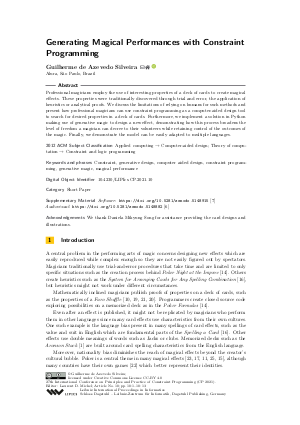Generating Magical Performances with Constraint Programming (Short Paper)
Author
Guilherme de Azevedo Silveira 
-
Part of:
Volume:
27th International Conference on Principles and Practice of Constraint Programming (CP 2021)
Part of: Series: Leibniz International Proceedings in Informatics (LIPIcs)
Part of: Conference: International Conference on Principles and Practice of Constraint Programming (CP) - License:
 Creative Commons Attribution 4.0 International license
Creative Commons Attribution 4.0 International license
- Publication Date: 2021-10-15
File

PDF
LIPIcs.CP.2021.10.pdf
- Filesize: 0.72 MB
- 13 pages
Document Identifiers
Subject Classification
ACM Subject Classification
- Applied computing → Computer-aided design
- Theory of computation → Constraint and logic programming
Keywords
- Constraint
- generative design
- computer aided design
- constraint programming
- generative magic
- magical performance
Metrics
- Access Statistics
-
Total Accesses (updated on a weekly basis)
0Document
0Metadata
Abstract
Professional magicians employ the use of interesting properties of a deck of cards to create magical effects. These properties were traditionally discovered through trial and error, the application of heuristics or analytical proofs. We discuss the limitations of relying on humans for such methods and present how professional magicians can use constraint programming as a computer-aided design tool to search for desired properties in a deck of cards. Furthermore, we implement a solution in Python making use of generative magic to design a new effect, demonstrating how this process broadens the level of freedom a magician can decree to their volunteers while retaining control of the outcomes of the magic. Finally, we demonstrate the model can be easily adapted to multiple languages.
Cite As Get BibTex
Guilherme de Azevedo Silveira. Generating Magical Performances with Constraint Programming (Short Paper). In 27th International Conference on Principles and Practice of Constraint Programming (CP 2021). Leibniz International Proceedings in Informatics (LIPIcs), Volume 210, pp. 10:1-10:13, Schloss Dagstuhl – Leibniz-Zentrum für Informatik (2021)
https://doi.org/10.4230/LIPIcs.CP.2021.10
BibTex
@InProceedings{deazevedosilveira:LIPIcs.CP.2021.10,
author = {de Azevedo Silveira, Guilherme},
title = {{Generating Magical Performances with Constraint Programming}},
booktitle = {27th International Conference on Principles and Practice of Constraint Programming (CP 2021)},
pages = {10:1--10:13},
series = {Leibniz International Proceedings in Informatics (LIPIcs)},
ISBN = {978-3-95977-211-2},
ISSN = {1868-8969},
year = {2021},
volume = {210},
editor = {Michel, Laurent D.},
publisher = {Schloss Dagstuhl -- Leibniz-Zentrum f{\"u}r Informatik},
address = {Dagstuhl, Germany},
URL = {https://drops.dagstuhl.de/entities/document/10.4230/LIPIcs.CP.2021.10},
URN = {urn:nbn:de:0030-drops-153018},
doi = {10.4230/LIPIcs.CP.2021.10},
annote = {Keywords: Constraint, generative design, computer aided design, constraint programming, generative magic, magical performance}
}
Author Details
Acknowledgements
We thank Daniela Mikyung Song for assistance providing the card designs and illustrations.
Supplementary Materials
- Software https://doi.org/10.5281/zenodo.5148915
- Audiovisual https://doi.org/10.5281/zenodo.5148882
References
-
Simon Aronson. A Stack To Remember. Self-published, 1979.

-
J. B. Bobo. WATCH THIS ONE! Lloyd E. Jones, 1947.

-
Robert Cassidy. The Art of Mentalism. Collectors' Workshop, 1984.

-
Michael Close. Workers Number 5. Self-published, 1996.

-
Michael Close. Closely Guarded Secrets. MichaelClose.com, 2 edition, 2004.

- Guilherme de Azevedo Silveira. Freedom of spelling demonstration, 2021. URL: https://doi.org/10.5281/zenodo.5148882.
- Guilherme de Azevedo Silveira. Freedom of spelling source code, July 2021. URL: https://doi.org/10.5281/zenodo.5148915.
- Guilherme de Azevedo Silveira. Generative magic, 2021. URL: https://github.com/guilhermesilveira/generativemagic/.
- Leonardo de Moura and Nikolaj Bjørner. Z3: An Efficient SMT Solver. In David Hutchison, Takeo Kanade, Josef Kittler, Jon M. Kleinberg, Friedemann Mattern, John C. Mitchell, Moni Naor, Oscar Nierstrasz, C. Pandu Rangan, Bernhard Steffen, Madhu Sudan, Demetri Terzopoulos, Doug Tygar, Moshe Y. Vardi, Gerhard Weikum, C. R. Ramakrishnan, and Jakob Rehof, editors, Tools and Algorithms for the Construction and Analysis of Systems, volume 4963, pages 337-340. Springer Berlin Heidelberg, Berlin, Heidelberg, 2008. URL: https://doi.org/10.1007/978-3-540-78800-3_24.
- Persi Diaconis, R.L Graham, and William M Kantor. The mathematics of perfect shuffles. Advances in Applied Mathematics, 4(2):175-196, 1983. URL: https://doi.org/10.1016/0196-8858(83)90009-X.
-
Karl Fulves. Hocus Poker. Self-published, 1982.

-
Glenn Gravatt. Encyclopedia of Self-working Card Tricks. Quality Magic Company, 1936.

- Charles R. Harris, K. Jarrod Millman, St'efan J. van der Walt, Ralf Gommers, Pauli Virtanen, David Cournapeau, Eric Wieser, Julian Taylor, Sebastian Berg, Nathaniel J. Smith, Robert Kern, Matti Picus, Stephan Hoyer, Marten H. van Kerkwijk, Matthew Brett, Allan Haldane, Jaime Fern'andez del R'ıo, Mark Wiebe, Pearu Peterson, Pierre G'erard-Marchant, Kevin Sheppard, Tyler Reddy, Warren Weckesser, Hameer Abbasi, Christoph Gohlke, and Travis E. Oliphant. Array programming with NumPy. Nature, 585(7825):357-362, 2020. URL: https://doi.org/10.1038/s41586-020-2649-2.
-
Pit Hartling. In Order To Amaze. Self-published, 2016.

-
Jean Hugard and Frederick Braue. The royal road to card magic. Farber and Farber, London, 1979. OCLC: 25036735.

-
Jean Hugard, John J. Crimmins, and Glenn G. Gravatt. Encyclopedia of card tricks. Dover Publications, New York, 1974.

-
Edward Marlo. The Ten Hand Poker Stack. Self-published, 1974.

-
Hugh Miller. Baker’s Bonanza. Supreme Magic Publication, 2 edition, 1978.

-
Stephen Minch. The Collected Works of Alex Elmsley, volume 2. L & L Publishing, 1994.

- S. Brent Morris. The basic mathematics of the faro shuffle. Pi Mu Epsilon Journal, 6(2):85-92, 1975. URL: http://www.jstor.org/stable/24345166.
- S.Brent Morris and Robert E. Hartwig. The generalized faro shuffle. Discrete Mathematics, 15(4):333-346, 1976. URL: https://doi.org/10.1016/0012-365X(76)90047-9.
-
Nike Arts. Enciclopedia de los juegos de cartas. RobinBook, Barcelona, 1999. OCLC: 807845266.

-
Darwin Ortiz. Darwin Ortiz on casino gambling: the complete guide to playing and winning. Dodd, Mead & Co, New York, 1st ed edition, 1986.

-
McCabe Pete and Michael Close. The PM Card System. MichaelClose.com, 2019.

-
David Regal. Close-up & personal. Hermetic Press, Seattle, Wash., 1999. OCLC: 45272617.

